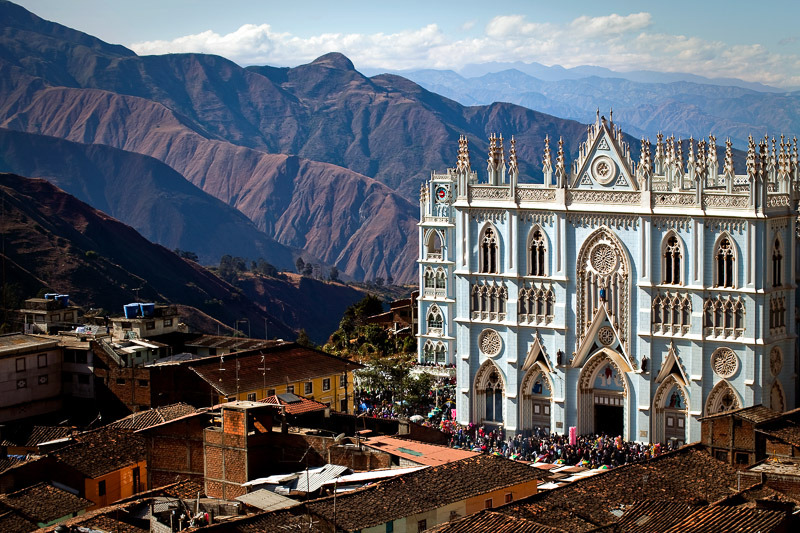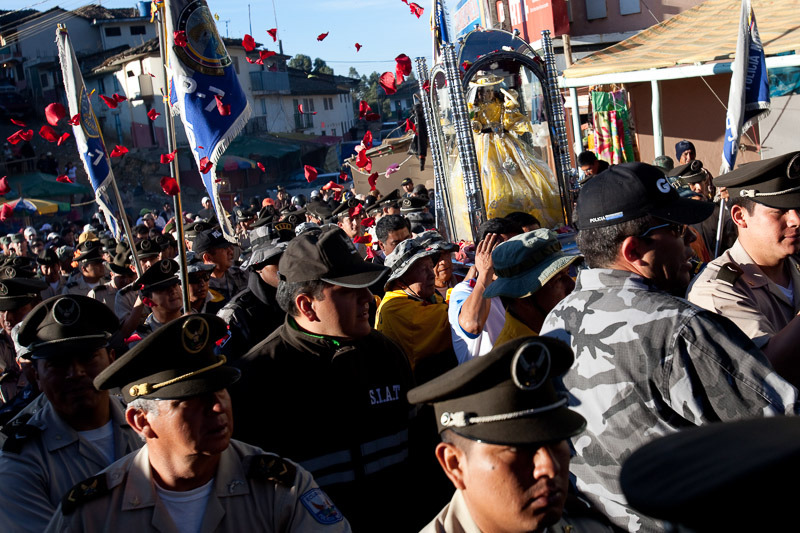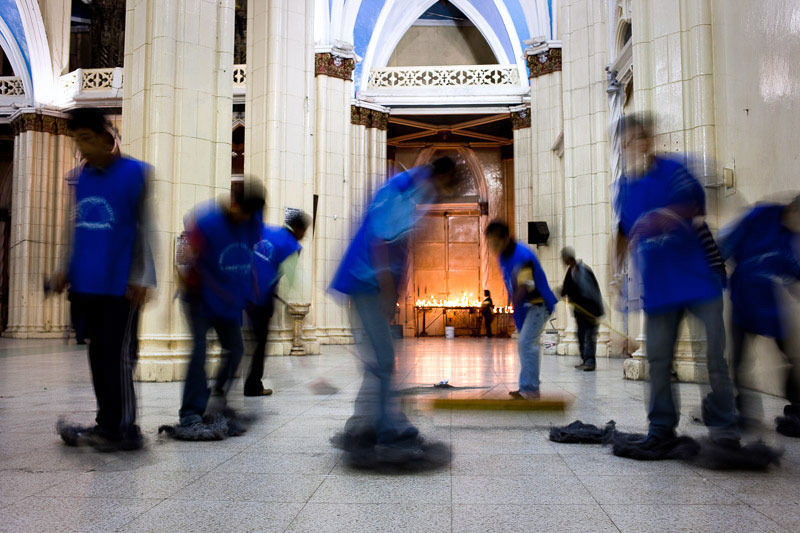
USE ARROW KEYS OR SCROLLING TO NAVIGATE

A fake, plastic backdrop of the basilica of El Cisne and La Virgen de El Cisne are set up directly outside the actual basilica for tourists to pose in front of and have their picture taken and printed for a few dollars. Thousands of faithful, tourists and opportunists flock to the Andean hamlet of El Cisne every August for the annual celebrations and pilgrimage procession.

El Cisne is a small town in the Ecuadorian Andes mountains and is the home to La Virgen de El Cisne. The Virgin was carved in the 16th century by Diego Robles and is believed to grant miracles to her followers. The church and the Virgin attract tourists and religious devotees all year but during August every year, a pilgrimage of followers accompanies the Virgin for three days to the provincial capital, Loja.

The wooden idol La Virgen de El Cisne is carried in a silver case and surrounded by a procession of police, military and believers during the beginning of the pilgrimage.

Under the watchful eye of her mother, Mercy Medina hot glues curly hair on a plastic doll to make it look like La Virgen de El Cisne. The Medinas have a kiosk outside the basilica where they sell religious items. The surge of people that come to El Cisne in August make it an important time for businesses there. This particular replica will sell for around $400, four times the Medina's average monthly sales at their kiosk.

Vidal Cruz takes a bath in a nearby river during the second day of the pilgrimage of La Virgen de El Cisne in southern Ecuador. Vidal has no legs but still traveled the entire 72 kilometer, three-day pilgrimage, using two wooden blocks to swing his body forward. He has been traveling the pilgrimage for 18 years. "When I am walking on the pilgrimage, I can go all day and it doesn't bother me," Cruz said after the pilgrimage. Cruz regularly received alms from other pilgrims that walk by and admire his tenacity. Cruz is Ecuadorian but lives in Lajas, Colombia with his wife Bertha and despite their small income from running a shop there, traveled from Colombia to El Cisne for the pilgrimage.

Padre Pablo throws holy water on Johnathan Alvara’s taxi to bless it following a mass. Alvara drove 14 hours from coastal town Marabí through the mountains to El Cisne, saw a mass, had his taxi blessed and plans to turn around and drive back immediately. He said his journey was fulfilling a promise he made to the Virgin 12 years ago.

A couple rests in the central park of San Pedro de la Bendita after the first day of the pilgrimage of El Cisne. Thousands of people filled the tiny town and any open spot on the ground became a place for people to sleep. Some pilgrims follow the entire procession and endure hardships as an offering to the Virgin and others walk only parts of the pilgrimage.

Kiosks selling religious items fill the courtyard directly outside the church in El Cisne. Business is booming in the days leading up to the annual pilgrimage, when the small town swells with thousands of people who come to see the Virgin.

Each kiosk outside the church in El Cisne offers hundreds of items with the image of La Virgen de El Cisne on them.

An image of La Virgen de El Cisne on the thumbnail of a man selling pictures to tourists.

A man holds up a small trinket with an image of La Virgen de El Cisne on it as priests splash worshippers with holy water. In the final days leading up to the pilgrimage, the small, usually sleepy town of El Cisne, Ecuador surges with thousands of people.

A procession closely follows La Virgen de El Cisne along the highway between San Pedro de la Bendita and Catamayo, Ecuador during the second day of the annual, Catholic pilgrimage in southern Ecuador. Every year thousands of faithful, tourists and business people follow the three-day pilgrimage that traces its roots to before Simón Bolivar.

A tent is set up underneath a religious statue beside the road that leads to El Cisne. Many people come from all over Ecuador to this small town to try and sell all sorts of things along the pilgrimage route to the thousands that flock there each year. Some set up makeshift camps along the road or walk the entire pilgrimage route selling, food, drinks and trinkets, becoming de facto pilgrims.

Since El Cisne fills with thousands of devotees and tourists who come to see La Virgen de El Cisne and the church before the start of the pilgrimage, other groups of business-minded people also come to sell anything they can, from food to photos with Barney.

A sweets vendor outside the church rests for a moment before closing up her shop for the evening. The Virgin and the church attract thousands of people from Ecuador and beyond, effectively providing a source of economic opportunity for residents of the small town.

At the end of the day in the basilica of La Virgen de El Cisne, young workers scrape the wax off of the church floor with steel pads. The church has a candle factory in El Cisne and recycles the wax to make new candles, which it sells to parishioners.

Fireworks displays called castillos (castles) and vacas locas (crazy cows) entertain the crowds every night outside the basilica of El Cisne. The expensive demonstrations are paid for by donors and considered offerings to the Virgin.

The church towers over the ramshackle, brick homes of El Cisne's residents. High in the mountains, the church, the Virgin and the visitors that come to see them are the lifeblood of this small town.

Praying during a mass inside the church that houses La Virgen de El Cisne.
